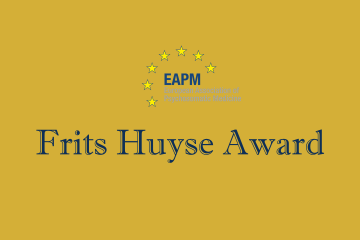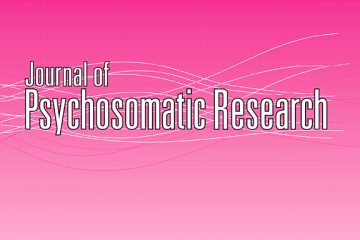The Editor’s choice October 2022
written by Jess G. Fiedorowicz, Editor-in-Chief, Journal of Psychosomatic Research, Professor and Senior Research Chair in Adult Psychiatry, University of Ottawa, Head and Chief of Mental Health, The Ottawa Hospital Scientist, Ottawa Hospital Research Institute, and Antonina Mikocka-Walus, Deputy Editor, Journal of Psychosomatic Research in October 2022.

Jess Fiedorowicz, JPR’s Editor-in-Chief
The Editor’s Choice –
“The interaction of the psychological and the social on cardiovascular events”
While the Journal of Psychosomatic Research routinely features research with a biopsychosocial scope, many papers tend to emphasize the psychological and some the social. Our Fall 2022 Editor’s choice looks closely at the interaction of a psychological (depression) and social (socioeconomic status (SES)) variable on major cardiovascular events. The journal has an extensive track record of publishing papers looking at depression and cardiovascular outcomes with several notable papers in the last year alone (1-5). When SES is considered, it is often conceptualized as a confounding variable and modeled in varied ways as a covariate, such as a dichotomized education threshold (5) or insurance type (3). We also have a number of papers looking at some measure of socioeconomic status and health outcomes (6-8). In their paper entitled “The individual and combined associations of depression and socioeconomic status with risk of major cardiovascular events: A prospective cohort study,” the UK team of Regina Prigge, Sarah Wild, and Caroline Jackson investigate how these two important psychosocial health determinants interact (9). The authors summarize their work with the following:
Our study examined the individual and combined association of depression and different measures of socioeconomic status (SES) with risk of major cardiovascular events (MCVE) in 466,238 UK Biobank participants aged 40 – 69 years at baseline. We found that each of depression, low education, high area-based deprivation and low income were individually associated with increased risk of MCVE. Individuals with depression of low SES were at particularly high risk of MCVE, irrespective of which measure of SES was used. The combined effect of depression and high area-based deprivation was greater than that expected from the individual effects.
The authors’ approach to consider both depression and SES as exposures of interest is laudable and their focus on the interaction between these variables innovative. Manuscripts occasionally assess interaction to determine the impact of a putative moderator on some exposure of interest. In this most comprehensive analysis to date on the topic, both exposures are of interest, and in the case of at least one measure of SES, area-based deprivation, there is evidence of synergy.
For the analysis, depression was based on hospital record or self-reported diagnosis of depression or antidepressant use. SES is clearly an important determinant of health outcomes, but it is vexing to optimally measure. So, the authors utilized three binary measures. Educational attainment was dichotomized based on presence or absence of a college/university degree and income based on a previously used threshold (£31,000). The measure that later showed evidence of additive and multiplicative interaction, area-based deprivation was based on any scores over the average area-based deprivation. MCVE consisted of first ever fatal or non-fatal myocardial infarction or stroke. Survival analyses explored the associations between these outcomes of interest and their interaction on MCVE, adjusting for prespecified covariates.
Regardless of the SES measure used, depression was significantly associated with MCVE at each stratum. While associations between depression and MCVE were stronger in those with lower education or income, there was no evidence of additive or multiplicative interaction. In the case of area-based deprivation, however, interactions were significant on both an additive and multiplicative scale. The hazard ratio associated with depression was substantially higher for those in high deprivation areas (HR 1.42, 95% C.I. 1.27 – 1.60) compared to those in average or low deprivation areas (HR 1.14, 95% C.I. 1.04 – 1.26). This provides clear evidence of synergy, as classically defined by Kenneth Rothman as when “the risk attributable to a combined exposure exceeds the sum of the risks attributable to each exposure separately (10).”
It is difficult to discern why moderation was found so strongly for one SES measure and not others and the interested reader is invited to read the authors’ discussion of this (9). Each measure was relatively crude and modeled as a binary variable. Future analyses may want to consider continuous measures, where possible. A previous analysis by our statistical editor, Paul Lodder, our Editor’s Choice in the Summer of 2020, showed how modeling interaction of the components of Type D personality as dichotomous rather than continuous variables has the potential to yield Type II error when only one of the main effects is significant (11). For our current Editor’s choice, depression was clearly categorical both in conceptualization and in the available data and SES measures can be challenging to model continuously if data such as income is captured in categories. Interactions with subjective SES, which has strongly been associated with health outcomes, even beyond objective SES (12), may present another opportunity of interest. We look forward to see future submissions to the Journal of Psychosomatic Research addressing these questions and helping us better understand these relationships. If your team is engaged in research tackling these questions, please send it to us for consideration.
References
- van Zutphen EM, Kok AAL, Rhebergen D, van Schoor NM, Huisman M, Beekman ATF. Comparing cardiovascular disease incidence and prevalence between depressed and non-depressed older persons over time: Cohort differences in the Longitudinal Aging Study Amsterdam. J Psychosom Res. 2022;162:111015.
- de Hartog-Keyzer JML, Pedersen SS, El Messaoudi S, Nijveldt R, Pop VJM. Psychological distress is independently related to new coronary events at 8 years’ follow-up in elderly primary care patients with hypertension. J Psychosom Res. 2022;160:110980.
- Hooker SA, O’Connor PJ, Sperl-Hillen JM, Crain AL, Ohnsorg K, Kane S, et al. Depression and cardiovascular risk in primary care patients. J Psychosom Res. 2022;158:110920.
- Piantella S, Dragano N, Marques M, McDonald SJ, Wright BJ. Prospective increases in depression symptoms and markers of inflammation increase coronary heart disease risk – The Whitehall II cohort study. J Psychosom Res. 2021;151:110657.
- van Zutphen EM, Kok AAL, Rhebergen D, Huisman M, Beekman ATF. The joint effects of clinically relevant depressive symptoms and cardiovascular risk factors on incident cardiovascular disease among older adults in the community. J Psychosom Res. 2021;149:110572.
- Aguiar A, Pinto M, Duarte R. The bad, the ugly and the monster behind the mirror – Food insecurity, mental health and socio-economic determinants. J Psychosom Res. 2022;154:110727.
- Barbek RME, Makowski AC, von dem Knesebeck O. Social inequalities in health anxiety: A systematic review and meta-analysis. J Psychosom Res. 2022;153:110706.
- Abdollahpour I, Mooijaart S, Aguilar-Palacio I, Salimi Y, Nedjat S, Mansournia MA, et al. Socioeconomic status as the strongest predictor of self-rated health in Iranian population; a population-based cross-sectional study. J Psychosom Res. 2019;124:109775.
- Prigge R, Wild SH, Jackson CA. The individual and combined associations of depression and socioeconomic status with risk of major cardiovascular events: A prospective cohort study. J Psychosom Res. 2022;160:110978.
- Rothman KJ. Synergy and antagonism in cause-effect relationships. Am J Epidemiol. 1974;99(6):385-8.
- Lodder P. Modeling synergy: How to assess a Type D personality effect. J Psychosom Res. 2020;132:109990.
- Hoebel J, Lampert T. Subjective social status and health: Multidisciplinary explanations and methodological challenges. J Health Psychol. 2020;25(2):173-85.




0 Comments